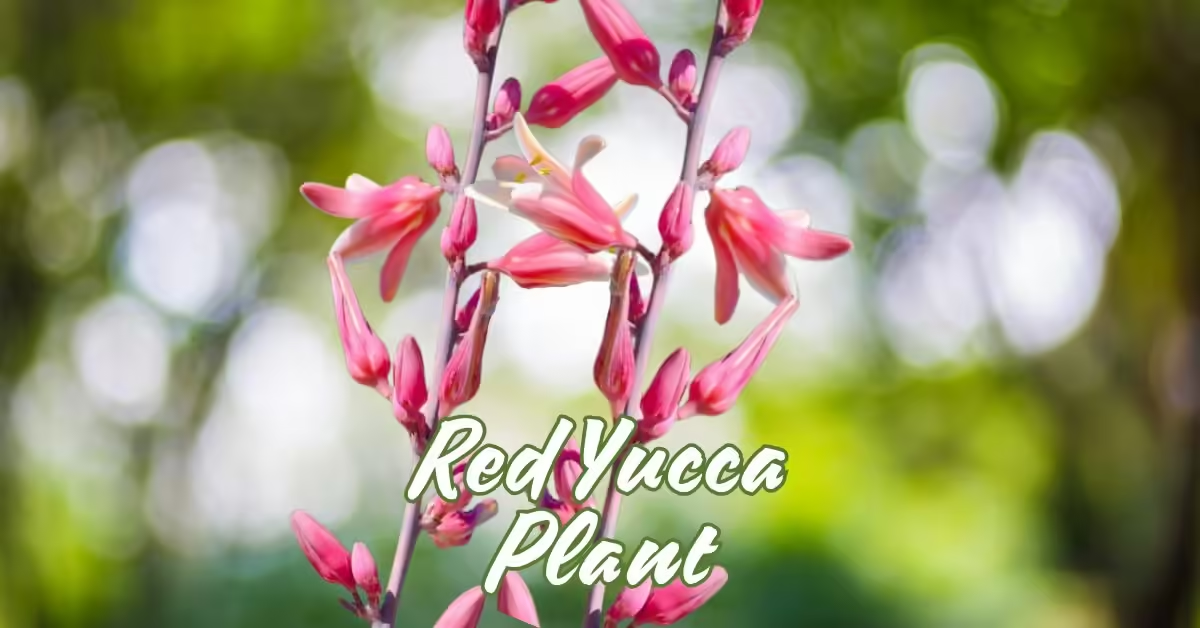The red yucca plant (Hesperaloe parviflora) is a stunning, low-maintenance plant that adds a vibrant touch to gardens and landscapes. Native to the deserts of Texas and northern Mexico, this drought-tolerant plant thrives in hot, dry conditions, making it a popular choice for xeriscaping. Its bright, coral-red flowers attract hummingbirds, making it an excellent ornamental plant for eco-friendly gardens. If you’re interested in growing and caring for the red yucca plant, this guide will walk you through everything you need to know.
What is the Red Yucca Plant?
The red yucca plant is not a true yucca, but it shares many similarities with the yucca family. It belongs to the Agave family and features long, arching leaves with a grass-like appearance. During the blooming season, it produces tall flower stalks filled with tubular, red or pink flowers. These flowers can last for months, adding beauty to your landscape for extended periods.
Unlike traditional yuccas, the red yucca does not have spiny leaves, making it a safer choice for homes with children or pets. Its ability to thrive in poor soils and harsh climates makes it a favorite among gardeners seeking a low-maintenance yet decorative plant.
Red Yucca vs. Regular Yucca: What’s the Difference?
Although they share similarities, red yucca plants differ from regular yuccas in a few ways:
- Leaf Texture: Red yucca has soft, thin leaves, while regular yuccas have thick, spiny leaves.
- Flower Shape: Red yucca produces tubular flowers in shades of red or pink, whereas regular yuccas usually have white bell-shaped flowers.
- Growth Habit: Red yucca grows in clumps with long, arching leaves, while traditional yuccas tend to be upright with stiff, sword-like leaves.
This comparison makes the red yucca a more practical and safer choice for residential landscaping projects.
How to Grow and Care for Red Yucca Plants
Growing a red yucca plant is relatively simple, as it requires little care once established. Here are the essential steps to grow and maintain healthy red yuccas:
- Light: Red yucca plants prefer full sun and need at least 6-8 hours of direct sunlight each day to bloom properly.
- Temperature: They are well-suited for hot climates and can tolerate temperatures up to 100°F (38°C). In colder regions, they need protection during the winter.
- Watering: Red yuccas are drought-tolerant and only require occasional watering once established.
This plant is perfect for gardeners looking for low-water landscaping solutions or xeriscaping.
Best Soil and Fertilizer for Red Yucca Plants
Red yucca plants thrive in well-drained soil with low fertility. They do not tolerate standing water, so sandy or gravelly soil is ideal. If your garden soil retains too much moisture, consider adding perlite or sand to improve drainage.
While red yuccas don’t need regular fertilizing, applying a balanced fertilizer once a year in early spring can encourage growth and blooming.
Red Yucca Blooming Season: When and How to Expect Flowers
The blooming season for red yucca plants typically begins in late spring and lasts throughout summer, often extending into early fall. During this time, the plant produces long stalks adorned with vibrant, tubular flowers that attract hummingbirds and pollinators.
If you want to enjoy an extended blooming period, ensure the plant gets plenty of sunlight and water it sparingly to mimic its natural habitat.
Landscaping Ideas with Red Yucca Plants
Red yuccas are versatile plants that work well in various landscaping designs. Here are a few landscaping ideas where you can incorporate red yuccas:
- Rock Gardens: Plant red yuccas among stones and succulents for a desert-inspired look.
- Borders and Edges: Use red yucca plants to line pathways or garden borders, adding a pop of color.
- Container Gardening: Red yucca plants thrive in large containers, making them suitable for patios or balconies.
Their drought tolerance makes them ideal for xeriscaping projects aimed at conserving water.
How to Propagate Red Yucca: Step-by-Step Guide
Propagating red yucca plants can be done through division or seed propagation. Follow these steps to propagate the plant successfully:
- Division Method:
- Wait until early spring or fall to divide the plant.
- Carefully dig around the plant and separate the clumps.
- Replant the divisions in well-drained soil.
- Seed Propagation:
- Collect seeds from dried flower stalks at the end of the season.
- Soak the seeds in water for 24 hours to improve germination.
- Plant the seeds in a tray filled with sandy soil and keep them warm.
Both methods are effective, but division ensures faster growth.
Watering and Maintenance Schedule for Red Yucca Plants
The red yucca plant requires minimal watering. Here is a general watering schedule to follow:
- Spring to Fall: Water every 2-3 weeks, depending on rainfall.
- Winter: Water once a month or not at all if the plant is dormant.
Avoid overwatering, as it can lead to root rot. Additionally, prune spent flower stalks to encourage new blooms and maintain the plant’s shape.
Red Yucca Winter Care: Protecting Your Plant from Cold Weather
Although red yucca plants are tolerant of heat, they need winter protection in regions with harsh winters. Here are some tips for winter care:
- Mulch: Add a layer of mulch around the base to insulate the roots.
- Covering: Use frost blankets to cover the plant during extreme cold.
- Indoor Containers: If grown in containers, move them indoors to prevent frost damage.
Following these steps will help your red yucca survive the winter months without issues.
Common Pests and Diseases of Red Yucca (And How to Fix Them)
Red yuccas are generally pest-resistant, but they can occasionally attract scale insects and mealybugs. Use insecticidal soap or neem oil to treat infestations. Root rot can also occur if the plant is overwatered, so ensure proper drainage.
Is the Red Yucca Plant Safe for Pets?
The red yucca plant is generally considered non-toxic to pets, but it’s still a good idea to keep curious animals away from the plant to avoid any accidental ingestion.
How to Deal with Red Yucca Plants That Won’t Bloom
A common concern for gardeners is when a red yucca plant doesn’t bloom as expected. While these plants are low-maintenance, certain factors can hinder flowering. Here are some tips to encourage blooming:
- Increase Sunlight Exposure:
- Ensure your plant receives at least 6-8 hours of full sun daily. In shaded areas, blooming is often reduced.
- Avoid Overwatering:
- Too much water can cause root rot and limit flowering. Stick to a light watering schedule, especially during dormant seasons.
- Prune Dead Stalks Regularly:
- Removing spent flower stalks encourages new growth. It also prevents the plant from wasting energy on old blooms.
- Apply Fertilizer in Early Spring:
- Use a low-nitrogen fertilizer to stimulate flower production rather than excessive leaf growth.
If these adjustments are made, your red yucca should begin blooming by the next growing season.
How to Use Red Yucca Plants for Erosion Control
The red yucca plant is not only decorative but also highly practical for areas prone to soil erosion. Its deep roots anchor the soil, preventing it from washing away during heavy rains. This makes it an excellent option for hillsides, slopes, and dry riverbeds.
Why Red Yucca is Effective for Erosion Control:
- Drought Tolerance: Red yuccas thrive in areas with minimal water, making them suitable for arid regions with unpredictable rainfall.
- Clumping Growth: The plant forms thick clumps, creating a natural barrier against erosion.
- Minimal Maintenance: Once established, red yucca plants need little care, making them perfect for hard-to-reach areas.
By planting red yuccas strategically on slopes, you can enjoy both beauty and functionality, all while reducing soil erosion naturally.
How to Prevent Common Red Yucca Problems
While red yucca plants are hardy, they can still encounter some issues. Below are common problems and how to address them effectively:
- Yellowing Leaves
- Cause: Overwatering or poor drainage.
- Solution: Allow the soil to dry out and ensure proper drainage to prevent waterlogging.
- Root Rot
- Cause: Standing water around the roots.
- Solution: Plant in well-drained soil and reduce watering frequency.
- Pests
- Problem: Mealybugs and scale insects can occasionally attack the plant.
- Solution: Use neem oil or insecticidal soap to get rid of infestations.
- Frost Damage
- Problem: Leaves turn brown after exposure to extreme cold.
- Solution: Trim the damaged leaves in spring, and use frost blankets for winter protection.
Can Red Yucca Plants Grow Indoors?
Although red yucca plants are primarily grown outdoors, they can thrive indoors if provided with the right conditions. Here’s how you can successfully grow a red yucca plant inside:
- Light: Place the plant near a south-facing window to ensure it gets plenty of sunlight.
- Container Size: Use a large container with drainage holes to accommodate the plant’s root system.
- Watering: Water only when the soil feels dry to the touch. Indoor plants need even less water than outdoor ones.
- Temperature: Keep the indoor temperature between 60-85°F (15-29°C) for optimal growth.
Indoor red yucca plants might not bloom as readily as outdoor ones, but they still make for beautiful, decorative houseplants.
How to Pair Red Yucca with Other Plants for a Stunning Landscape Design
Red yuccas work well in companion planting due to their low water needs and striking appearance. Here are some plants that pair well with red yucca for a balanced landscape:
- Succulents (Aloe, Agave, or Echeveria):
- These plants have similar water needs and complement the red yucca’s bold leaves.
- Ornamental Grasses (Blue Fescue or Fountain Grass):
- The soft texture of ornamental grasses contrasts beautifully with the rigid structure of red yucca.
- Flowering Plants (Lavender or Coneflowers):
- These add bursts of color while thriving in similar conditions as red yucca.
When used in combination, these plants create a visually appealing and drought-tolerant landscape perfect for homeowners looking for sustainable garden designs.
For more tips and guides, visit our homepage at My Read Magazine and explore a world of helpful content!
Conclusion
The red yucca plant is an attractive, low-maintenance option for gardens and landscapes. With its vibrant flowers, drought tolerance, and minimal care requirements, it’s no wonder that this plant has become a favorite among homeowners and landscapers alike. Whether you use it in rock gardens, as a border plant, or in containers, the red yucca is sure to enhance the beauty of your outdoor space.
10 Frequently Asked Questions About Red Yucca Plants
- How often should I water my red yucca plant?
– Water every 2-3 weeks during the growing season and reduce watering in winter. - When does the red yucca bloom?
– It blooms from late spring to early fall. - Can red yucca survive winter?
– Yes, but it needs protection in cold climates. - Is red yucca toxic to pets?
– No, it is generally safe for pets. - How tall do red yucca plants grow?
– They can grow up to 4-6 feet tall. - Can I grow red yucca in containers?
– Yes, they thrive in large containers. - What type of soil is best for red yucca?
– Well-draining, sandy soil is ideal. - Do red yucca plants attract pollinators?
– Yes, their flowers attract hummingbirds and bees. - How do I propagate red yucca plants?
– You can propagate by division or seeds. - What is the best fertilizer for red yucca?
– Use a balanced fertilizer once a year in early spring.
Emma Rose is a professional writer with over 3 years of experience covering a wide range of topics, including health, lifestyle, and technology. She is known for her in-depth research and commitment to providing accurate, trustworthy, and engaging content. Emma’s work focuses on delivering value to readers by simplifying complex topics and ensuring every article meets high editorial standards.




